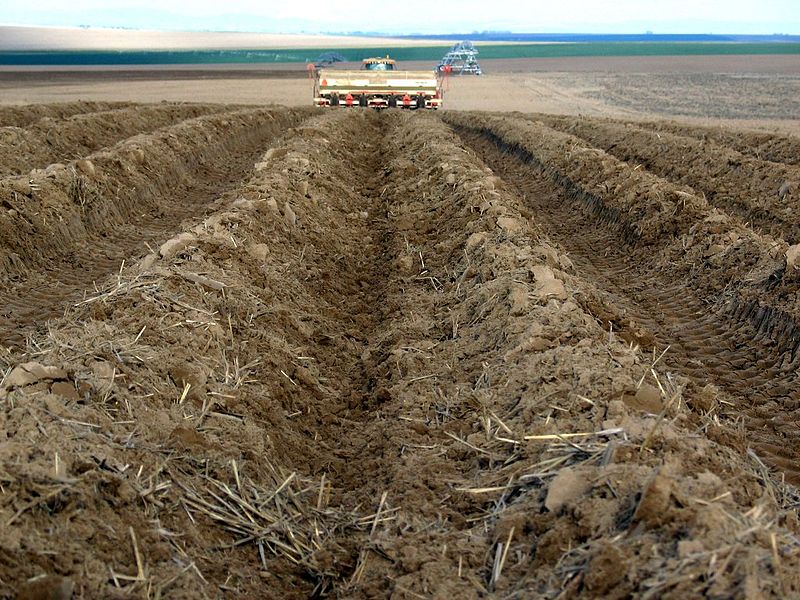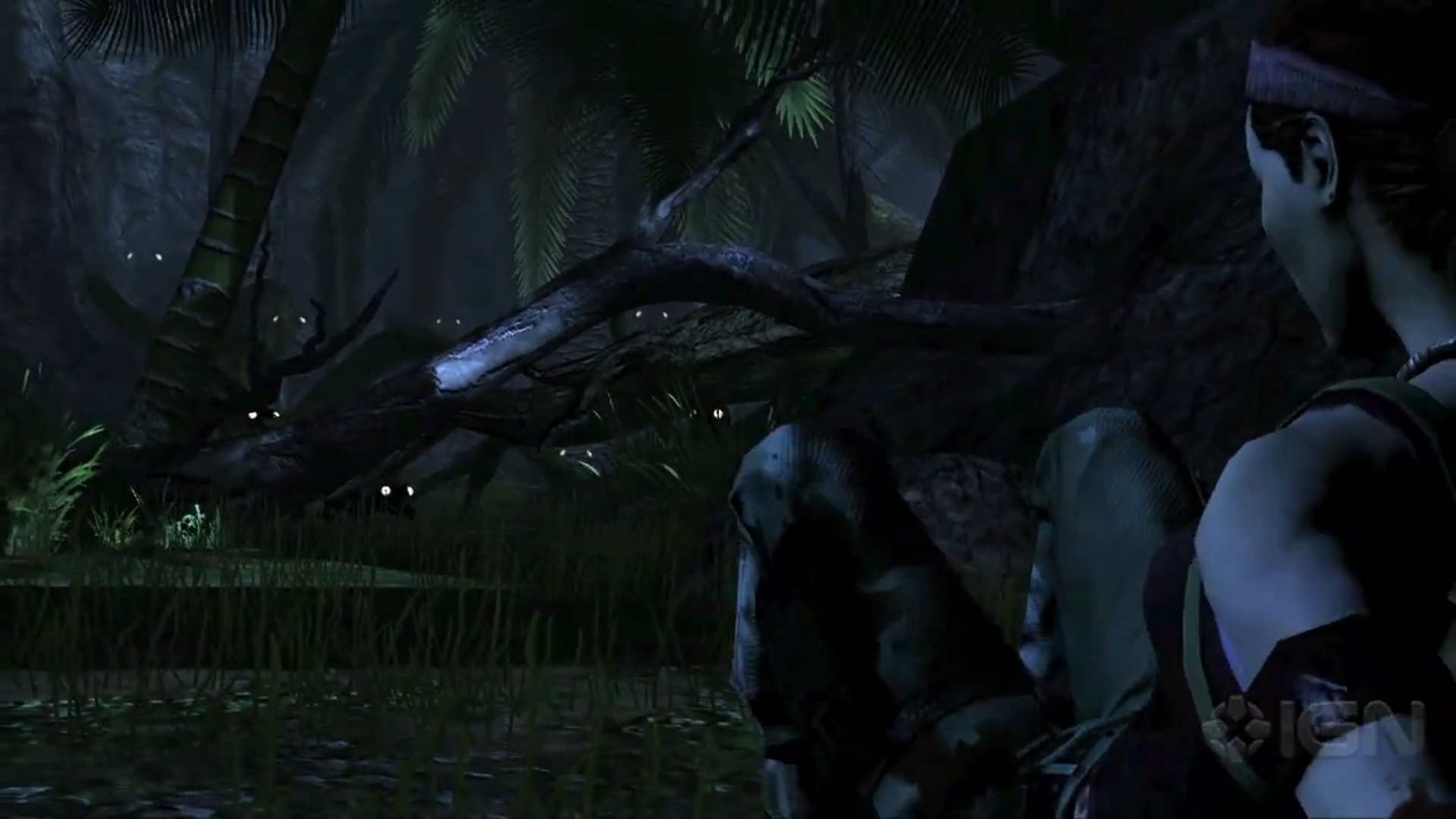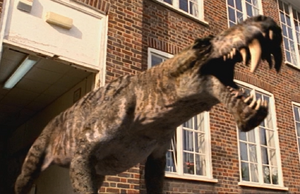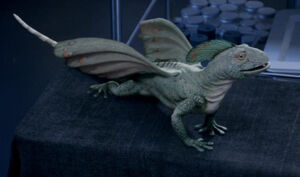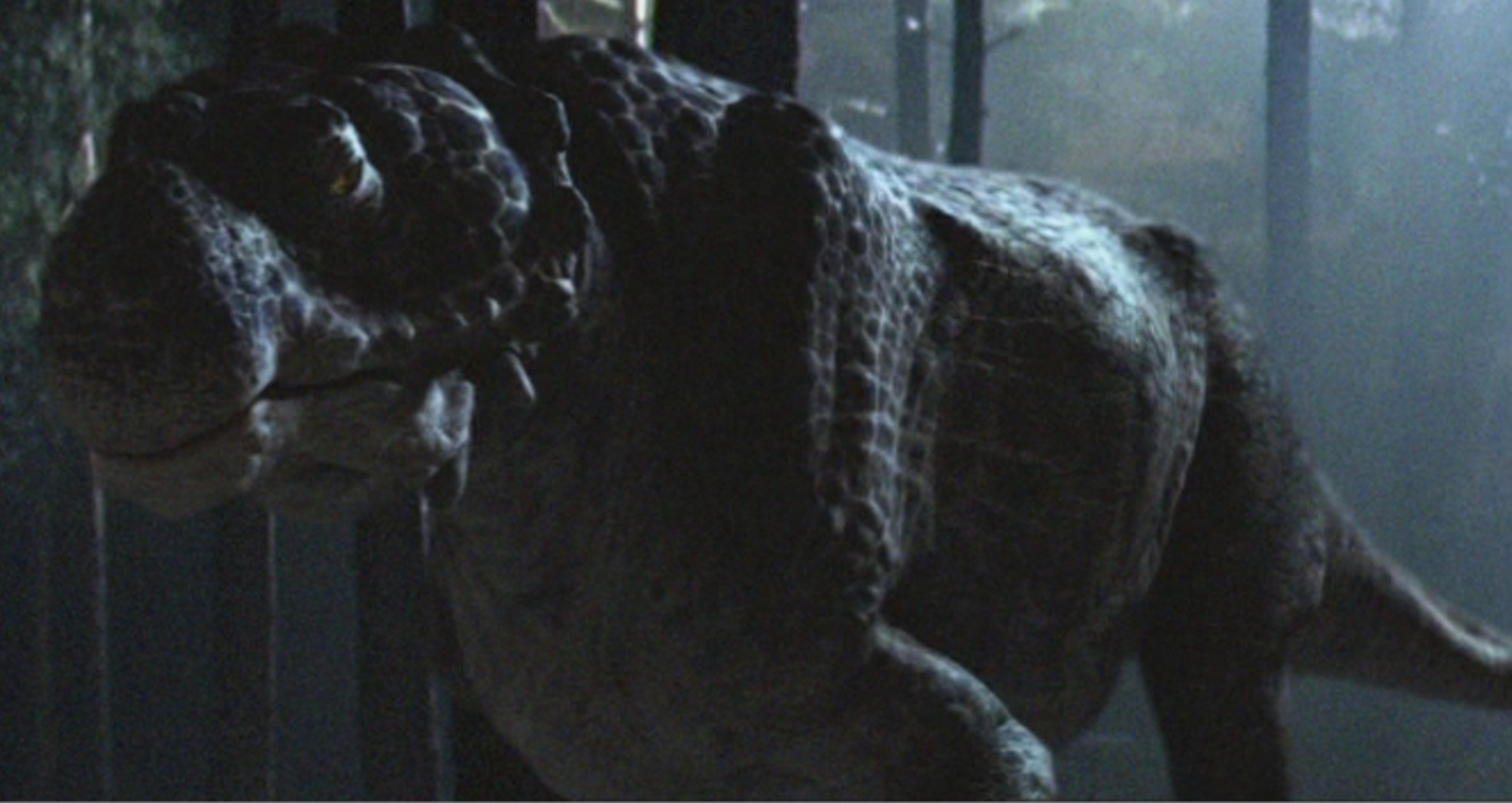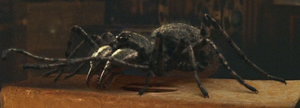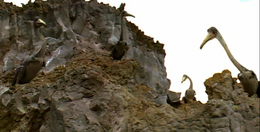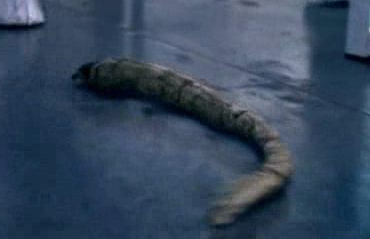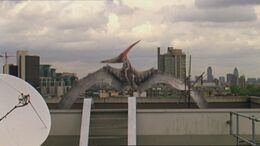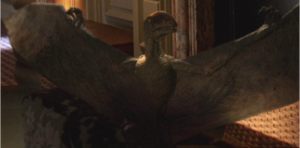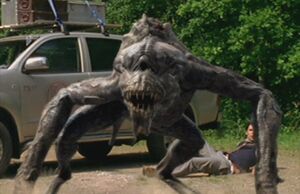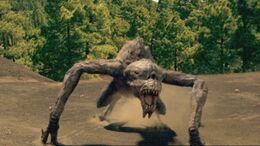Finally, we have lots of updates coming in from various films
that I've been giving updates on! And when I say “lots”, I mean A LOT!
So without further ado, let's begin looking at these movie updates before
today's non-fiction article.
First up is Jurassic World! (This film was previously
known as Jurassic Park IV) Last week, I reported the name change of the
film, and last week, JP fans have been a buzz about the recent
apparently leaked trailer from the movie. Before I continue talking about why
it's been in the news over the past few weeks, you can view the video below:
Now, before I go on, you might want to know what MY opinion
on the clip is, in terms of quality (not necessarily how it relates to the
film): I think it's a pretty cool! For those of you who don't know, the flying
creature portrayed in the clip is a pterosaur, often incorrectly referred to as
a “flying dinosaur”. The exact species is undetermined, but it looks like one
of the two largest pterosaurs – either Quetzalcoatlus or Hatzegopteryx.
Both of these fliers had a wingspan of 35 to almost 40 feet and were the
largest animals ever to take to the wing – ever! The clip portrays one of these
monster pterosaurs terrorizing a beach (presumably on the mainland) and
snatching a surfer off of the water. Then it flies high in the air and tosses
it to another pterosaur which might be its mate. It is unknown what the
pterosaurs do with their catch, but perhaps they are going to feed it to their
young. I doubt Quetzalcoatlus and Hatzegopteryx are the scary new
“dinosaurs” planned for the movie, but they definitely could make an appearance
in the film.
So why has this clip been in the news so much last week?
Well, when first released on the internet, Frank Marshall (the film's producer)
said that it was not a part of the movie and other sources said it was a
trailer from a canceled Jurassic Park-related game. But there aren't any
JP-related games that were canceled with the title “Jurassic World”
that we know of. What's the real deal? It turns out that the clip was actually
from 2011 when it was used as a concept clip to help the film's producers and
directors get an idea of what the movie was about. Apparently, the movie's
creators didn't find it interesting enough so it was scrapped.
It turns out we still don't have a trailer for this film yet,
as everything is pretty much “hush-hush” at this point. However, it's likely a
teaser trailer will appear next summer since the movie's supposed to come out
the summer of the following year on June 18 2015. I can't wait till then!
Recently, I talked about two upcoming movies from Pixar
Animation Studios called The Good Dinosaur and Finding Dory.
Originally the first was supposed to be released in 2014 while the latter was
due to come out in 2015. Pixar though, has decided as of last week to
move the release dates of the films a year or so back. That means The Good
Dinosaur was supposed to come out on May 30, 2014, it will now come out on
November 25, 2015 and the other will be released in the summer of 2016. The
cause? Well, it turns out that the film's director Bob Peterson, was pulled
from the film's development and
according to them, the director is connected to everyone else working on the
movie. So Pixar is moving these movies back so they can make sure they
make a great movie. Just like Jurassic World, the date of these films
shifts too! That figures! Now Pixar is releasing no movies in 2014.
| Here's some concept art for the movie The Good Dinosaur. |
If you're like me and not into most of the other movies that
come out into theaters each year, you might think that 2014 could be a very
boring year concerning movie-releases. Not so fast! There is yet another movie
I've been giving updates on and it's a sequel to a great family movie that was
released in 2011 – the movie is Dolphin Tale.
 |
| Here's the theatrical poster for Dolphin Tale 1. |
Dolphin Tale is the
inspiring story about a bottlenose dolphin later named Winter. The poor dolphin
loses her tail thanks to it being caught in a crab trap (it had to be amputated)
and is brought to the Clearwater Marine Aquarium (CMA). But the film's heroes,
11-year olds Sawyer Nelson (Nathan Gamble) and Hazel Haskett (Cozi Zuehlsdorff)
put together a plan to make a prosthetic tail for her. As I said when I last
reported about Dolphin Tale 2, in addition to the original main cast
returning to the film, we'll also see the appearance of another dolphin named
Hope who also resides at the CMA in real life, will be playing herself in the
film.
 |
| Winter still resides at CMA to this day. |
Recently, the aquarium's been getting a lot of publicity due
to the recently released documentary narrated by Cozi Zuehlsdorff (now 15 years
old) called Winter: The Dolphin That Can. Cozi has made her appearance
at the aquarium several times in the past few years since the film's release,
including one last week to promote the new documentary. “It definitely helped
with the three years in-between the last time shooting here and Dolphin Tale
2,” Cozi explains. “You don't feel disconnected. Since (Dolphin Tale)
was my first movie, I would've felt heartbroken just leaving and being done
with it.”
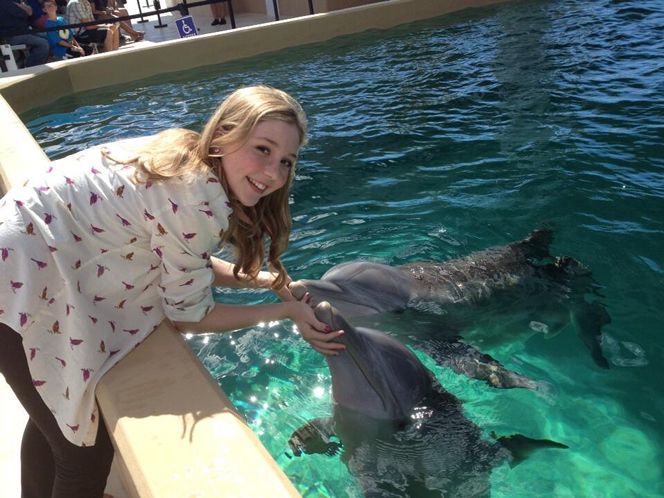 |
| Cozi Zuehlsdorff at the CMA during a special event in 2013. |
This is a little off topic, but I really congratulate actors
like Cozi (not in person, of course) who not only are Christians, but also
won't hesitate to make it known (Jesus Himself says we're the salt and light of
the earth!). Cozi is quoted for saying, “I would be working more, if I was very
open in the things that I audition for. I'm a Christian and I'm very careful.
I'm interested in inspiring people with my life, and in the way I carry myself.
Doing a project that's really inappropriate, that has a really bad rating, that
has bad language, that has a lot of sexual content; those are the things that
I'm careful to not be involved with, per se.” (If that doesn't deserve a round
of applause I don't know what does!) Cozi is interested in finding uplifting
and more “family-friendly” roles to play in movies.
Cozi and the rest of the Dolphin Tale 2 cast will
start filming this October and the film itself is planned to be released
September 19, 2014. I can't wait! (and let's hope and pray it doesn't get
pushed back like the other movies!)
We all know what a potato is – “it's a large vegetable that
makes great for french fries,” you might say. But there's so much more to the
potato than what meets the eye, as I found out recently when my family and I
went to a local farm to help the farmers harvest potatoes. For instance, did
you know that the United States produced 19.4 million metric tons of potatoes
in 2011? Or that worldwide we produced 374.4 metric tons of potatoes also in
2011? That also means the average citizen ate 73lbs of potatoes during the
first decade of the 21st century! Originally, I wasn't so sure
whether or not I'd like doing potatoes, but I soon found out it was a lot of fun.
So get ready to learn more than you ever thought you could about one of
America's most eaten vegetables – the mighty potato!
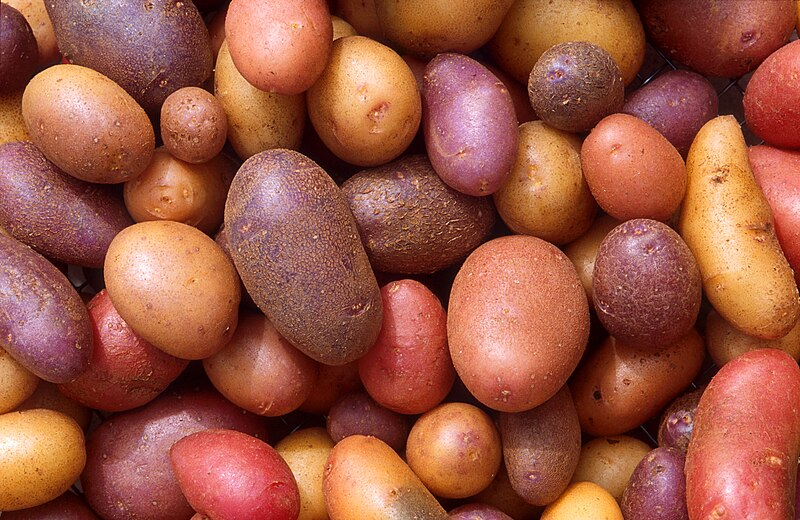 |
| Potatoes come in a wide range of colors. |
Like every widely
consumed food, potatoes have an origin. After all, the potato didn't
start out as thinly cut fries that sit upright in a cardboard carton
from McDonald's! Potatoes were probably first domesticated sometime
after the Noachian Flood in Peru somewhere between 3,000 and 4,000 years
ago, definitely after the great Ice Age glaciers that covered much of
the earth vanished. It was thanks to the potato that the Old World was
able to grow rapidly on population between 1700 and 1900. Right after
the Spanish conquest of the Inca Empire, these Spanish people brought
back potatoes to Europe in the 16th century and they apparently became quite popular. But that leads us to a very obvious question: how do you grow a potato?
 |
| There's more to potatoes then them getting chopped up into french fries at Dairy Queen and other fast food chains. |
Well, I learned the
answer to that question when we helped harvest potatoes at a nearby farm
not long ago. First of all, did you know that unlike many plants,
potatoes aren't grown from seeds? While potatoes do produce seeds, if
you plant them, they won't grow like you want them to. Instead, farmers
grab potatoes from previous harvests and replant them. These are called
“Mother Potatoes” because, as their name suggests, they reproduce more
potatoes. After the Mother Potatoes are placed on the ground in long
rows, they get covered in long mounds of dirt and the potato takes root .
. . sort of (technically, the potato is a root). From the root
extensions of the Mother Potato grow baby potatoes, and before you know
it, they're just as big as their mother once was. The Mother Potato
meanwhile, simply disintegrates into what looks like dead potato skin.
Then we simply have to wait until the “baby” potatoes grow.
 |
| . . . tada! Potato plants bloom and the harvest begins! |
Soon it comes time to
harvest the potatoes. When this time comes, the farmers go out to the
potato fields and attach a large plow-like machine (it was powered by
hydrolics at the farm we helped at) to the back of a tractor and they
drive the tractor and the plow-like machine over each mound and it
scoops up earth, plants and the potatoes. Next, using an apron chain
made up of steel links, it picks up the potatoes and drops them as
lightly as possible behind the machine as it continues to repeat the
process.
Finally it comes time
to actually do the harvesting itself. One of the most striking things
I've learned about potato harvesting is that you don't want to harvest
green potatoes. Green potatoes aren't a different species of potato, but
they actually turn green when exposed to to much light. Like most
plants, potatoes naturally photosynthesize (use sunlight to make energy)
when exposed to too much sunlight. The farm we went to cast out green
potatoes, but some farms don't do this at all or aren't as careful to
spot them before boxing them up to ship off, so sometimes they appear in
the store. Remember:NEVER eat green potatoes or drink potato
leaf tea because these two things that many people often consume are
actually poisonous! Potatoes are filled with toxic compounds called
glycoalkaldoids and solanine. Solanine is also found in nightshade,
henbane, tobacco, eggplant and the tomato. In potatoes, these toxins are
located in the leaves, stems, sprouts and fruits; fortunately, it's
normally not enough to be a threat to humans in domesticated potatoes.
Wild potatoes are a totally different story! Notice two sentences ago
that I said “normally not enough to be a threat to humans”. The
exception is when the potato is either when it's been through physical
damage, aging and as mentioned before, light exposure. Even though
cooking at over 340ºF destroys most of the toxins, it doesn't completely
eliminate them. And if you're still not convinced about not eating
green potatoes or drinking potato leaf tea, here's a list of symptoms
that might instantly change your mind:
 |
| DON'T EAT TOXIC GREEN POTATOES! Remember what happened when Adam and Eve disobeyed God by eating the fruit they weren't supposed to eat? A lot of bad stuff happened . . . |
Remember: NEVER eat green potatoes or drink potato leaf tea because
these two things that many people often consume are actually poisonous!
Potatoes are filled with toxic compounds called glycoalkaldoids and solanine.
Solanine is also found in nightshade, henbane, tobacco, eggplant and the
tomato. In potatoes, these toxins are located in the leaves, stems, sprouts and
fruits; fortunately, it's normally not enough to be a threat to humans in
domesticated potatoes. Wild potatoes are a totally different story! Notice two
sentences ago that I said “normally not enough to be a threat to humans”. The
exception is when the potato is either when it's been through physical damage, aging
and as mentioned before, light exposure. Even though cooking at over 340ºF
destroys most of the toxins, it doesn't completely eliminate them. And if
you're still not convinced about not eating green potatoes or drinking potato
leaf tea, here's a list of symptoms that might instantly change your mind:
- Headaches
- Diarrhea
- Cramps (not too bad so far)
- Coma
- DEATH
So in short, if you value your life: never eat green potatoes
or drink potato leaf tea!
Last
but not least, we dumped our potatoes carefully in the main batch and
our job of harvesting potatoes was done! I actually enjoyed the whole
process and learned a great deal about potatoes. And I'm sure without a
doubt that you've learned a great deal more about potatoes than you've
known before (unless you or someone you know is a potato farmer of
course, or you did your research). So now that you know much more about
the potato, share this information with friends and impress your family
at the dinner table. Wow, what an amazing vegetable – the awesome
potato!
 |
| A potato with butter, now you're talking . . . ! |
PS 1: To post a comment (this is highly encouraged), please
simply click the post you wish to comment on, scroll to the bottom of the page
and put what you wish to say or ask in the comment box. Then in the box below
the comment box choose who you’re going to comment as. And then click preview or publish. If you aren’t signed into Google, you’ll be asked to type
in a word and a number in the space provided. Type the word, put a space and
then put the number. Then your comment is on the blog!
PS 2: Have a puzzling question about animals (including
dinosaurs), myself, my latest book, my stop-motion movies, Creation or etc?
Please post your question as a comment or send me an email at animaladventures@aol.com.
PS 3: What’s the latest scoop? Check it out at SMILEY’S NEWS.
PS 4: Be sure to comment on the latest stop-motion movies
too, this will help me improve them.
